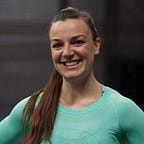Incontinence and CrossFit. Five Things You Can Try Now to Help
Ladies…. we’ve all been there, right? Maybe it’s coughing, sneezing, box jumps, running, or going for that max attempt on a lift when all of a sudden you’re a bit wet. So you try squeezing or holding your breath, or maybe you try not to drink as much and wear a panty liner on those days. Girl, you’re not alone and I want you to know that just because something is COMMON does not mean there isn’t help. Here are 5 things you can start doing today to help alleviate incontinence and keep you dry.
1) Relax.
I know, I know. This sounds counterintuitive. Relax the belly and let it go, relax the pelvic floor.
Maybe you’re thinking, NO! If I feel like I’m going to pee myself, I’m going to squeeze to stop it!
But really, our pelvic floor acts like a trampoline. It is meant to have give and if we are always squeezing or clenching it doesn’t have that chance to relax. Thinking about catching a ball with your hands. If you hold your hands out flat and don’t move them, the ball will bounce right off. But, if you absorb the ball as you catch it by moving your hands back, you can catch it. Our pelvic floor is similar when it comes to absorbing impact and preventing leaks. Relaxing may allow the pelvic floor the ability to absorb impact better, and therefor prevent leaks.
2) Breathe.
This runs along the same lines as number 1. When you hold your breath (this especially goes for during your workouts/lifting), you could be creating and trapping in some pressure. It can get to a point where that pressure needs to be released… and that release can come in the form of urinary incontinence. So if you tend to hold your breath, try breathing through your movements whether you are picking up your groceries or a barbell. There is no right way to do it, try exhaling on the “hard” part and if that’s not helpful try inhaling on the “hard” part.
3) Check your body alignment.
It’s easy, especially in the middle of an intense workout, to change body alignment. And for some of us, we don’t even know what our alignment tendencies look or feel like. The main focus here should be to keep the ribs over the hips, ribs level, and hips untucked as a starting point. See how that works and feels for you. *Note that there are varying degrees of “correct” as we are all individuals with different needs.*
4) Establish a breathing technique that works for you.
Breathing technique is essential to our cause here of staying dry. Piston breathing is one way of breathing that takes all components of breath (diaphragm, abdominals, and pelvic floor) and has them working together (up and down like a piston). This strategy is used and taught by Julie Wiebe, and can aide in helping rehabilitate and prevent pelvic floor dysfunction, including urinary incontinence. You can find her course here at the bottom of the page. *Note that this is not the only way, but a starting point as we are all individuals with different needs.*
5) See a Pelvic Floor Physical Therapist.
I saved the best for last. Yes, there is such a thing! Seeing a PFPT is invaluable to determine any pelvic floor issues you may have and create a therapy plan tailored to your needs. You can search here to find one in your area. Working with both a PF PT and knowledgable coach CAN help you alleviate this issue!
Just because something is common doesn’t mean there isn’t help! If you want it
If you are in Rhode Island, I can recommend an awesome PT! Please contact me directly for more information.
For more information about me and how I can help you through this chapter and start doing double unders with confidence, please visit kerrigrace.co for more information. As always, please feel free to reach out to me directly with any questions. You can reach me on Facebook, Instagram, or email me at hello@kerrigrace.co.
Stay strong, stay beautiful!
Coach Kerri
